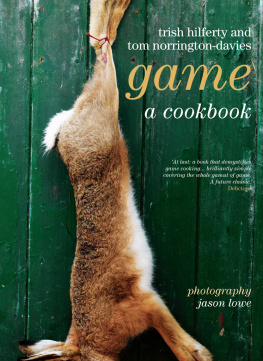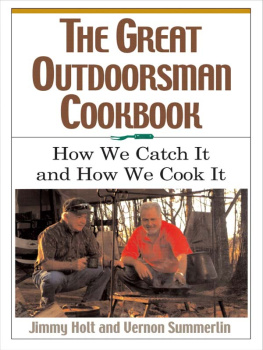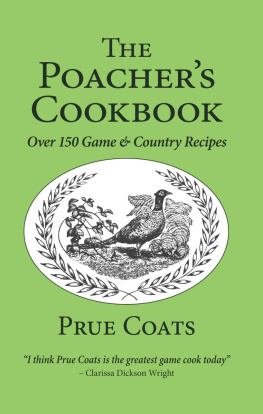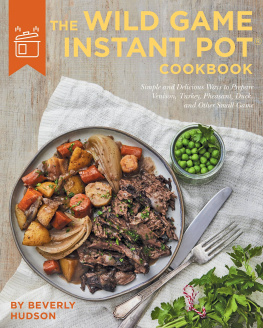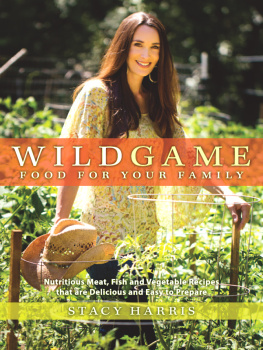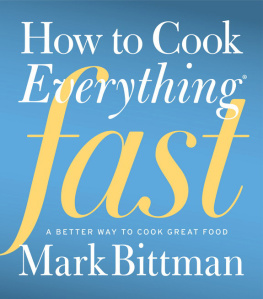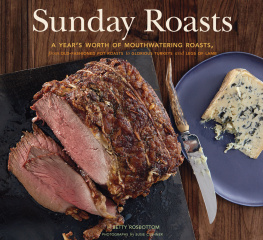
This book is dedicated to our Dads, Kevin Hilferty and John Butterworth. They are, quite simply, the kind of writers we aspire to be.
Whenever we are asked what kind of food we like to cook most, we are bound to reply, almost in unison,
game.
We are both seasoned and seasonal cooks. We love the ins and outs of the culinary calendar, whether that means waiting for our first handful of asparagus in spring, or a glut of tomatoes and pumpkins come early autumn. Even the so-called bleak midwinter provides a bounty of food, which extends far beyond cabbages and root vegetables, if you want it to. And, in fact, the reason we dont spend those colder months dreaming too much about the summer is probably because our cooking is dominated by the huge choice of game on offer. Game is not winter food by any means, but it is the best thing about that time of year. Why do we love it so much?
First up, it is the most unbelievably tasty food, naturally. Thats not naturally as in of course. Perhaps we should have said that it is naturally tasty! Next time you find yourself slathering a chicken breast with a marinade to save it from mediocrity, try swapping it for something that has literally walked on the wild side, and tastes like it.
Next time you find yourself worrying about the way your pork chop was treated on the farm, consider the genuinely free-range lifestyle of a rabbit, or a deer, or any number of other critters that roamed where they liked, and ate what they wanted.
Worried about cholesterol? Additives? Cost? Provenance? Game is, by and large, lean, unadulterated, cheap and local.
Bored of turning to the same recipes again and again? If you are new to game, you are about to discover a wealth of quick, easy, simple and delicious dishes that, despite being staggeringly uncomplicated, manage to thrill the taste buds on several levels all at once. Game never seems to taste the same twice. Just like a brilliant wine and its terroir, or a spankingly fresh oyster and its riverbed, game has such a close relationship with nature that it manages to delight and surprise you on some level every time you cook and eat it.
Before we go any further, we ought to roughly explain what we mean by game. If we were the types to rely on dictionary definitions we would simply describe game as wild animals now or formerly hunted for food and sport, then crack on with the bit you really bought this book for, the recipes. However, if you are reading this book curled up on a sofa and you fancy a bit of background to this marvellous subject then read on.

Whats in a name?
In Britain and most of Europe the word game is a purely culinary term used to describe wild (or at least wild-ish) meat and fish. You might still hear the word being used in other parts of the world to describe large, usually dangerous animals, hunted for trophies. Elephants in Africa, tigers in Asia and bison in the Americas were all once known as big game. This sport is, at least in theory, a dwindling practise, since many of those species that were once seen as big game are endangered and protected by anti hunting laws.
In the British Isles, where we have never had many big beasts to contend with; most hunting has been about pest control, and / or providing food. Now that hunting foxes with hounds has been banned, just about all the wild animals Britons trap and shoot are considered fit for the table. To understand why this food source is still known as game, you need to look at our ancient past.
Once upon a time man was a hunter-gatherer who lived entirely on what he could find or catch. As most humans morphed into agrarian societies who grew or raised their food, the wild stuff changed from being a staple to a supplement. In countries like this one, where pretty much the entire population has come to rely on well-established animal husbandry and industrially farmed crops, hunting has become, for better or worse, a much more leisurely pursuit. Your average modern hunter-gatherer indulges in little more than the occasional mushroom hunt or an afternoons blackberry picking. Some people are not exactly stimulated by the idea of pouncing on a patch of bramble and, for them, a far more exciting prospect involves quarry that presents some jeopardy. i.e. it will try and run away or, in some more extreme cases, put up a fight. However you feel about hunting, it is this very jeopardy or thrill factor that has given us the word game. When modern, well-fed humans hunt, they are not all that dissimilar to dogs chasing sticks.
The wild and the not-so-wild
Most of the game eaten in the British Isles, Europe and North America falls into one of three distinct groups. The first is a pretty motley crew of truly wild animals, but in such densely populated parts of the world, its members live in direct competition with humans, especially those who farm cereals, fruit or vegetables. Rabbits, pigeons, some deer and a whole host of less famous delinquents might be seen as game in the kitchen, but they could also be quite accurately described as vermin. Thanks doubtlessly to this wholly unappetising label, such animals are no longer widely eaten in the UK. Mores the pity, because they are all delicious. Whats more, they are extremely common and, as a result, incredibly cheap to buy for those of us who do not hunt. If we had a mission statement as both cooks and authors, it would probably be to get more people eating this confoundingly underrated food source.
The second group is probably the most famous and definitely the most popular. Most members of this group are related to (or at least taste like) animals that mankind has domesticated over the centuries. Grouse, pheasant and partridges all descend from ancient ancestors of the modern chicken. Wild ducks and other waterfowl are distant cousins of the farmyard goose. Venison is an herbivore that will provide meat to rival the best beef and lamb. All of the above can and do live wild in this part of the world. But, in Britain at least, mankind profoundly influences their lives and habitats.
Because these animals are either naturally shy, or migratory (or both) and tend to give humans a wide berth, finding and catching them presents a number of challenges, and they have become the darlings of the hunting community as a result. Because so much land in the UK is privately owned, hunting provides a valuable income to many farmers and estate keepers. Over the centuries they have learned to manage and control the local populations of those animals that attract the sporting hunter. In the case of birds like pheasant and partridge, it is common practise to rear chicks in a protective environment and release them into the wild as adults (and targets). The last Highland moor you hiked across may have been carefully manicured to encourage grouse. The same might be true of wetlands favoured by wild ducks and waders. We will deal with this management of Britains most popular game in each individual chapter but, for now, it is suffice to say that not all of our favourite wild food is particularly wild.
The third group is likely to cause contention amongst some game aficionados as to whether we should have included it at all. Some formerly wild animals that, for one reason or another, no longer proliferate in this country have been reintroduced on what can only be described as farms. They are raised, fed, managed and slaughtered for the table as a purely commercial venture. It is possible to buy farmed versions of nearly all Britains wild animals. Venison, rabbits, salmon and guinea fowl are the most obvious examples. But it is also possible to buy game that is not available in its wild form at all, such as wild boar or quails.
Next page
